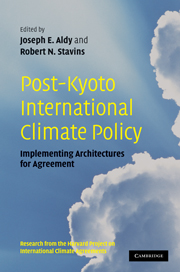Book contents
- Frontmatter
- Contents
- Harvard Environmental Economics Program, International Advisory Board
- Harvard Project on International Climate Agreements, Faculty Steering Committee
- Harvard Project on International Climate Agreements, Project Management
- List of figures
- List of tables
- List of contributors
- Foreword
- 1 Introduction
- Part I Alternative international policy architectures
- 2 An elaborated proposal for a global climate policy architecture: specific formulas and emission targets for all countries in all decades
- 3 The EU emission trading scheme: a prototype global system?
- 4 Linkage of tradable permit systems in international climate policy architecture
- 5 The case for charges on greenhouse gas emissions
- 6 Towards a global compact for managing climate change
- 7 Sectoral approaches to a post-Kyoto international climate policy framework
- 8 A portfolio system of climate treaties
- Part II Negotiation, assessment, and compliance
- Part III The role and means of technology transfer
- Part IV Global climate policy and international trade
- Part V Economic development, adaptation, and deforestation
- Part VI Modeling impacts of alternative allocations of responsibility
- Part VII Synthesis and conclusion
- Appendix A Selected List of Individuals Consulted, Harvard Project on International Climate Agreements
- Appendix B Workshops and Conferences, Harvard Project on International Climate Agreements
- Glossary and Abbreviations
- Index
7 - Sectoral approaches to a post-Kyoto international climate policy framework
Published online by Cambridge University Press: 05 June 2012
- Frontmatter
- Contents
- Harvard Environmental Economics Program, International Advisory Board
- Harvard Project on International Climate Agreements, Faculty Steering Committee
- Harvard Project on International Climate Agreements, Project Management
- List of figures
- List of tables
- List of contributors
- Foreword
- 1 Introduction
- Part I Alternative international policy architectures
- 2 An elaborated proposal for a global climate policy architecture: specific formulas and emission targets for all countries in all decades
- 3 The EU emission trading scheme: a prototype global system?
- 4 Linkage of tradable permit systems in international climate policy architecture
- 5 The case for charges on greenhouse gas emissions
- 6 Towards a global compact for managing climate change
- 7 Sectoral approaches to a post-Kyoto international climate policy framework
- 8 A portfolio system of climate treaties
- Part II Negotiation, assessment, and compliance
- Part III The role and means of technology transfer
- Part IV Global climate policy and international trade
- Part V Economic development, adaptation, and deforestation
- Part VI Modeling impacts of alternative allocations of responsibility
- Part VII Synthesis and conclusion
- Appendix A Selected List of Individuals Consulted, Harvard Project on International Climate Agreements
- Appendix B Workshops and Conferences, Harvard Project on International Climate Agreements
- Glossary and Abbreviations
- Index
Summary
Introduction (Background)
This chapter explores the potential for sectoral approaches to a post-Kyoto international climate policy framework. A number of sectorbased proposals have already been put forward; they share the concept that instead of the Kyoto-type, top-down approach of negotiating caps on economy-wide emissions for individual countries, a bottom-up approach should be taken in which technology assessments would be used to establish aggregate emission-reduction targets for different sectors of the world economy. Many surveys have been conducted on sectoral approaches and similar architectures (Bodansky 2003; Philibert 2005 and 2005b; The Pew Center 2005; Siikavirta 2006; IPCC 2007).
Sectoral approaches have not only been a subject of in-depth study in the academic community in recent years, they have also attracted growing interest in political circles as an option for multinational negotiations. Reference to a “cooperative sectoral approach” first appeared in the Bali Action Plan; since then, the Japanese government has led the world in developing specific proposals for making this approach the basis for negotiations on a framework to follow the Kyoto Protocol.
This chapter provides an overview of previous findings on sectoral approaches and presents options for using this concept as the basis for a next international climate policy architecture. It differs from previous studies in that it (1) clarifies the role of national governments in making legally binding commitments under international law to adopt domestic policies and measures for achieving sector-based mitigation targets; (2) categorizes emitting sectors into three groups in an effort to simplify and smooth negotiations; and (3) suggests a way forward for proceeding with negotiations.
- Type
- Chapter
- Information
- Post-Kyoto International Climate PolicyImplementing Architectures for Agreement, pp. 201 - 239Publisher: Cambridge University PressPrint publication year: 2009
- 4
- Cited by

